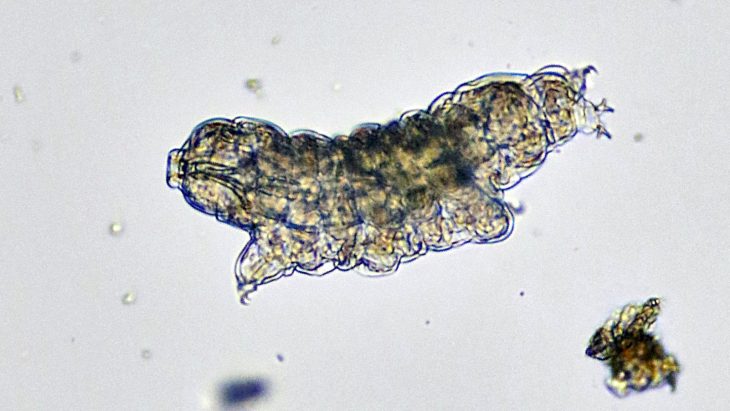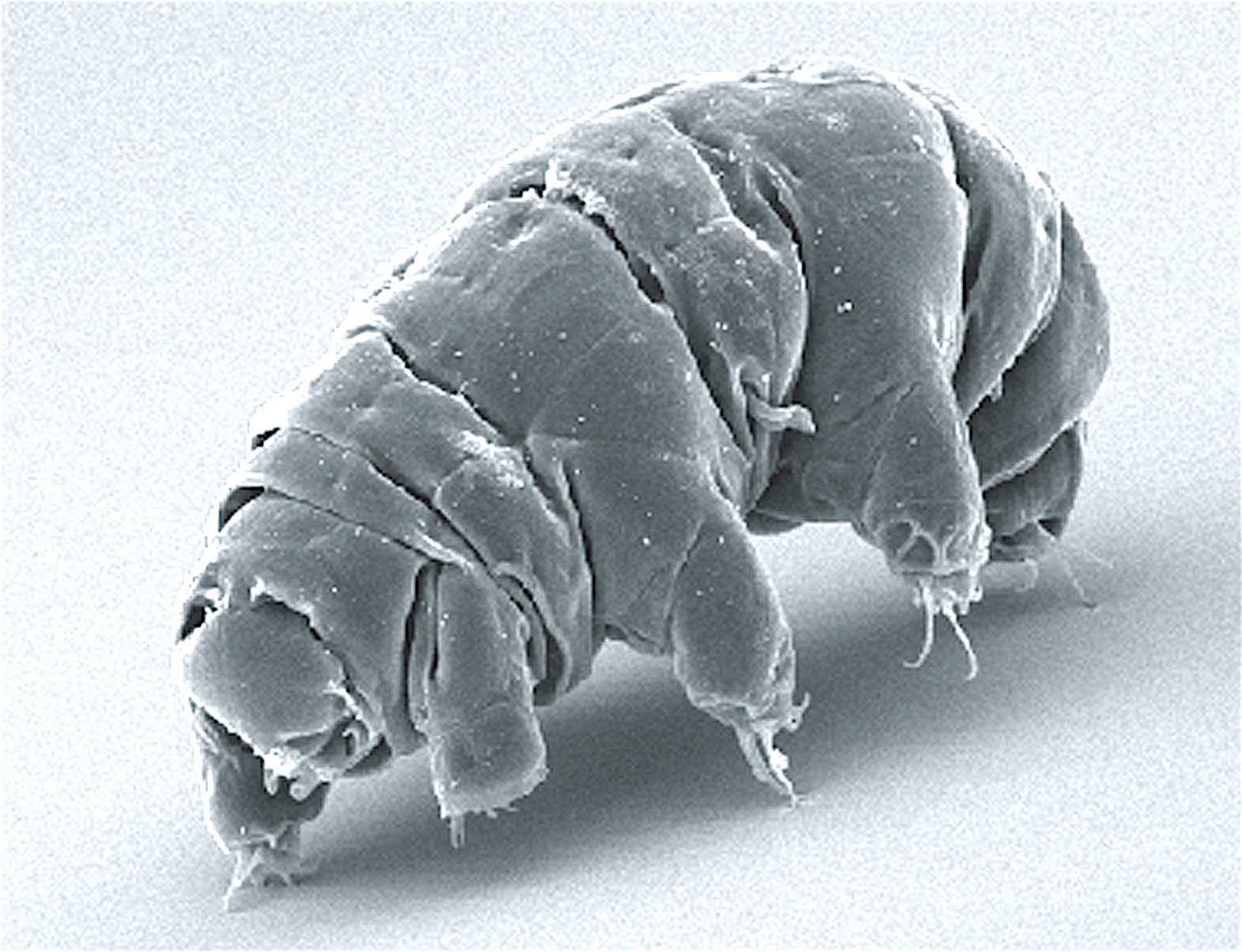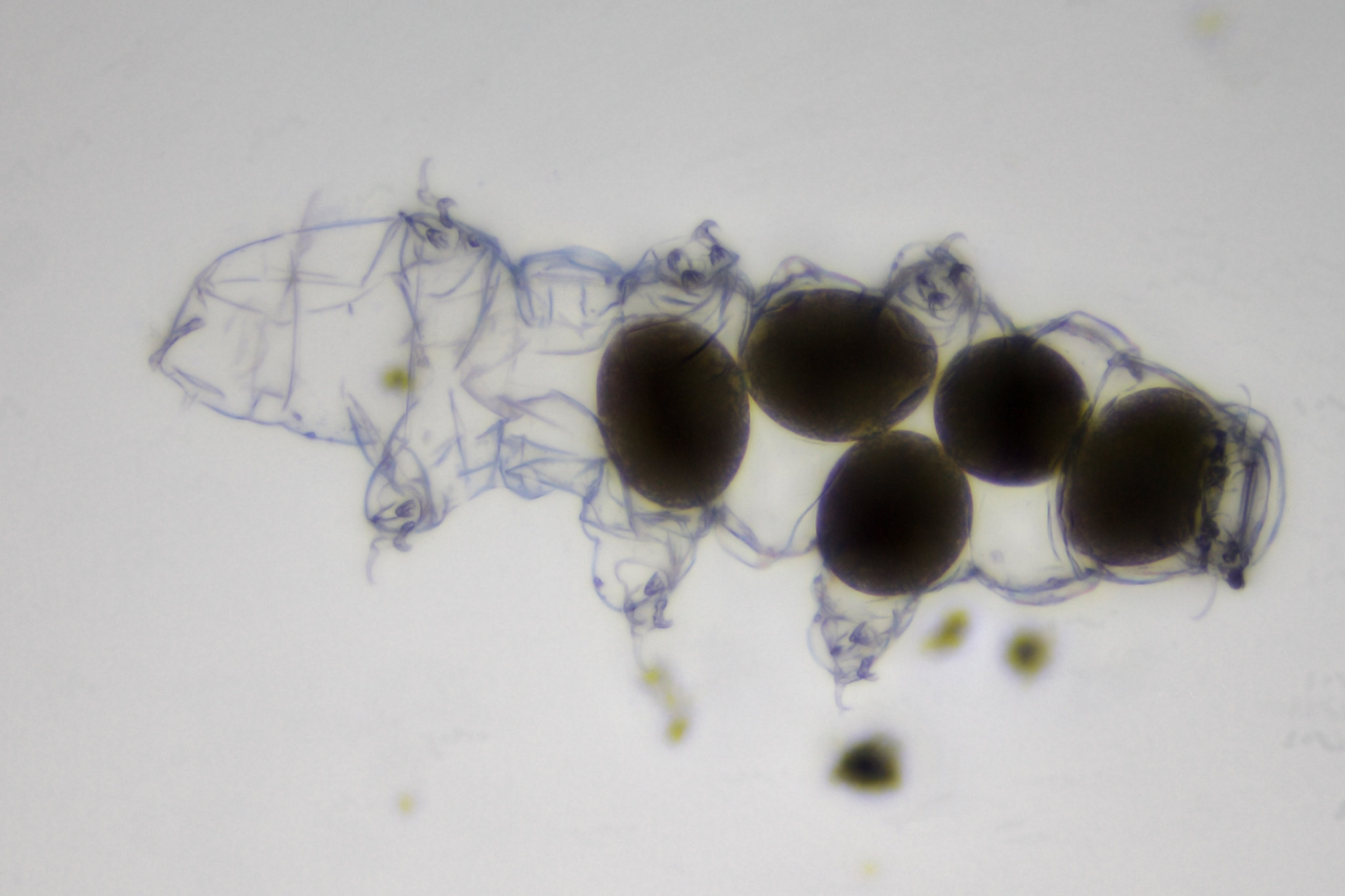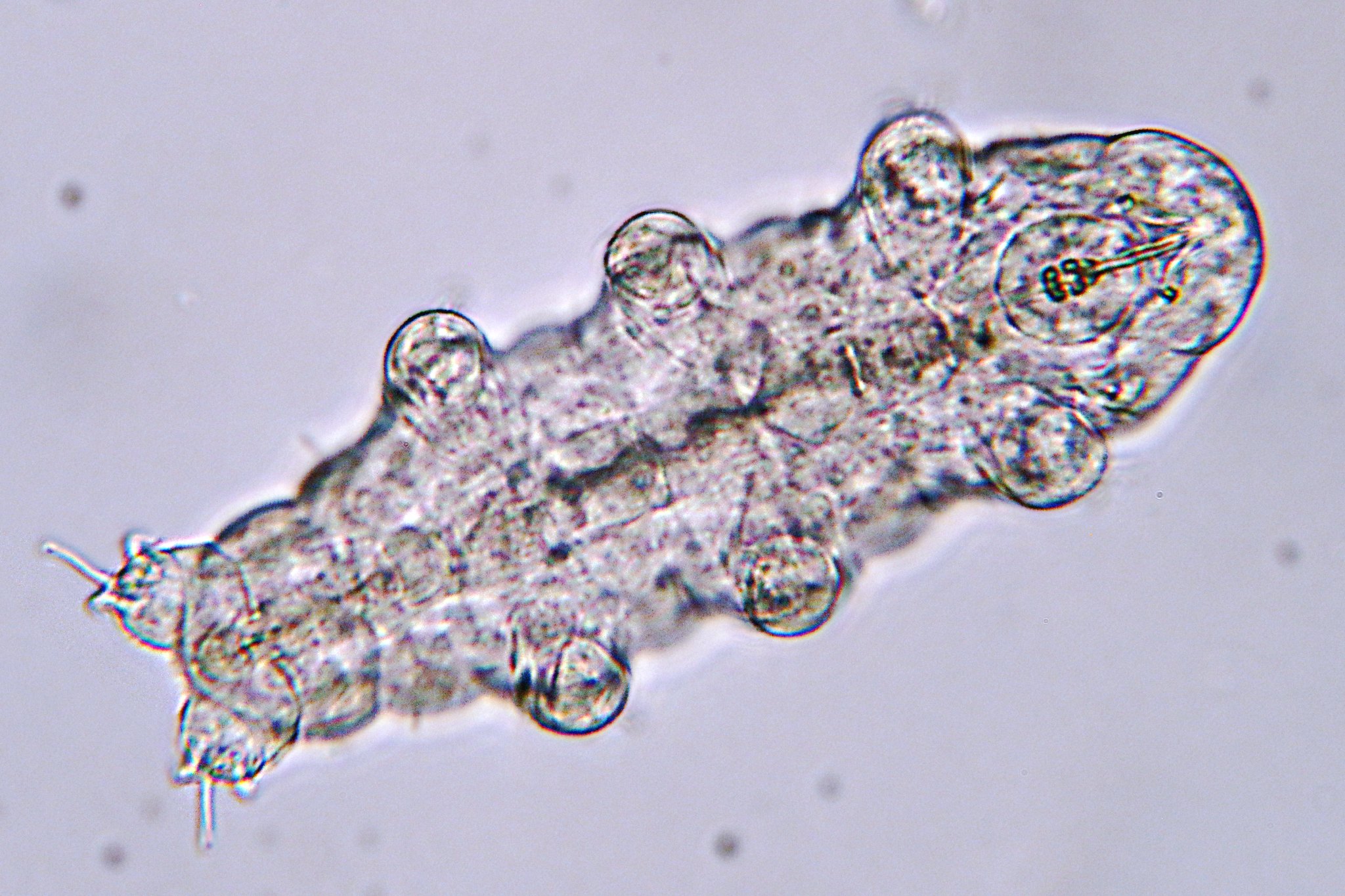
Tardigrades, water bears, or moss piglets are microscopic animals that don’t take survivability lightly. They are perhaps the world’s toughest animals. They can survive extreme conditions such as radiation, extreme pressures, and even the lethal vacuum of outer space. Moreover, these tough eight-legged invertebrates are nothing short of amazing and continue to fascinate scientists to this day. Learn more about these tiny and tough animals with these tardigrade facts.
- German zoologist Johann August Ephraim Goeze first described water bears in 1773. He called them “kleiner Wasserbär”, which means “little water bear”.
- The Italian biologist Lazzaro Spallanzani gave them the name “Tardigrada” in 1777.
- There are around 1,300 recorded species of tardigrade.
- Water bears move using their eight legs, and some species of tardigrade can swim.
- Tardigrades come in three main classes: Eutardigrada, Heterotardigrada, and Mesotardigrada.
- Tardigrades are multicellular micro-animals.
- Water bears earned their name from their bear-like gait.
- Some people refer to them as moss piglets because they live abundantly in moss.
- Water bears don’t have hearts.
- Tardigrades are harmless to humans and animals.
- Water bears belong to the phylum Tardigrada. The phylum name “Tardigrada” means “slow walker”.
- They don’t have lungs; gas exchange occurs throughout the water bears’ entire bodies.
- Each of their legs ends with either claw, adhesive pads, or discs. Some water bears also have telescopic legs that can extend and retract.
- Water bears have brains with multiple lobes.
- They can survive radiation that’s hundreds of times more potent than the lethal dose for humans.
- Echiniscoides wyethi, a species of marine tardigrade, lives on the bodies of barnacles.
- When tardigrades molt, they also shed off their gut linings. During their molting period, they cannot eat.
- In the 2015 Marvel superhero film Ant-Man, as well as its 2018 sequel Ant-Man and the Wasp, the characters encounter water bears as the characters shrink into the Quantum Realm.
- Water bears also help the Family Guy characters Stewie and Brian in the 2018 episode “Big Trouble in Little Quahog”.
- In the 2017 series Star Trek: Discovery, there is a large alien that the characters refer to as “Ripper”, a giant space tardigrade. Ripper first appeared on the episode “Context Is for Kings”.
You can see tardigrades with the naked eye — but it’s better to view them under a microscope.
One of the most interesting tardigrade facts is that with good eyesight and the right lighting conditions, you can see some adult tardigrades with the naked eye. However, it would be difficult to make out any details because they’re no bigger than a speck of dust.
Tardigrades are extremely small animals, with the sizes of various species ranging from 0.004 to 0.059 in (0.1 to 1.5 mm) in length. Newly-hatched tardigrades are even smaller, having lengths of less than 0.002 in (0.05 mm). To add to their minuscule size, most tardigrades are transparent, making them harder to detect. Some non-marine species, however, can have quite colorful bodies.
Due to their small size, it’s best to view water bears under a microscope. Even a low-power microscope will suffice, making tardigrades readily available for students and amateur scientists to study.
Tardigrades can live virtually anywhere on Earth.
Water bears are extremely diverse and naturally occur in every continent. As a diverse phylum, these micro-animals can live practically anywhere on Earth. They can live in terrestrial, freshwater, or marine habitats. Researchers have found them living in the Himalayan Mountains in altitudes as high as 19,685 ft (6,000 m) and in the oceans as deep as 15387 ft (4,690 m).
Most commonly, as their name implies, water bears live in aquatic or semi-aquatic habitats. They also live abundantly in bryophytes or mosses. Different species occur in different habitats, and some can only live under specific environmental conditions.
Tardigrades can turn into dehydrated balls to survive extreme pressures and temperatures.
Among the most essential tardigrade facts is their unique ability to undergo cryptobiosis under unfavorable conditions. This means that under extreme temperatures or a lack of water, these animals can temporarily slow down their metabolism to 0.01 percent of their original rate. This allows water bears to almost completely shut down their bodily functions, helping some tardigrades survive extreme environmental conditions such as temperatures of 1 K (-458°F; -272°C) and even up to 420 K (300°F; 150°C) for a few minutes.
When a tardigrade enters a cryptobiotic state, it dehydrates itself and turns into a seemingly lifeless ball or “tun”. Tuns contain about 1% of the tardigrades’ normal water content. To turn into tuns, water bears make use of sugars and proteins to protect their membranes, proteins, and the water in their bodies.
As tuns, tardigrades can survive for years or even decades until they reach more livable environments. External forces such as wind and water can easily carry them away in their tun state.
Tardigrade tuns can temporarily survive even without food, water, or oxygen.
As previously mentioned, tardigrades can suspend their metabolism when they turn into tuns. By doing so, they can survive without food or water for over 30 years and continue to live normally once they return to their original state. Some water bears may even survive in this state for a few days without oxygen.
This article belongs to Facts.net and may not be reproduced, copied, edited, published, transmitted, or uploaded in any way without the permission of Facts.net.
They can survive the vacuum and radiation in outer space.

A list of tardigrade facts wouldn’t be complete without their most impressive feat — they’re the only animals that have survived after they’ve been exposed to outer space. In 2007, scientists took groups of tardigrades to outer space, with some of them in the tun state. They then exposed the tardigrades for 10 hours.
During their exposure, they experienced the hard vacuum of space, the lack of oxygen, as well as the ionizing radiation from the Sun. Surprisingly, most of the ultraviolet-protected water bear tuns survived when scientists brought them back to Earth. Many of them died shortly after they returned to their normal states, however. Three tardigrades of the species Milnesium tardigradum even survived outer space without protection from ultraviolet (UV) radiation.
Tardigrades crash-landed on the Moon.
In April of 2019, thousands of tardigrade tuns crash-landed on the Moon aboard Beresheet, a failed Israeli spacecraft. The crash landing scattered the animals across the surface of the Moon, and scientists speculate that the tuns likely would have survived. However, the chances of them living normal lives on the Moon are low, given that they still would need liquid water, food, and adequate oxygen to thrive there.
Water bears survived all five mass extinction events.
One of the most amazing tardigrade facts is that these tough animals are even older than dinosaurs and have survived all five of Earth’s mass extinction events. Because of this, water bears have evolved their characteristic survival mechanisms.
Due to their small size and their lack of bones, only a few fossil records of early tardigrades exist. However, rare fossil records show that tardigrades likely split off from Lobopodia (a group consisting of arthropods and velvet worms) around 500 million years ago in the Cambrian period.
Tardigrades may be tough, but they’re not immortal.
Although water bears can survive extreme temperatures, pressure, radiation, starvation, and other harsh environmental conditions, they aren’t immortal. Long-term exposure to extreme heat and radiation can kill tun-state tardigrades. Pollution can also lead to a decrease in water bear populations, as environmental conditions such as acid rain, air pollution, and increased heavy metal concentrations can negatively affect their habitats. Because of their sheer diversity and survivability, however, tardigrades don’t face the threat of extinction — they may even outlive the human race!
Water bears normally have short lifespans.
Despite surviving for decades in their tun states, they rarely live past 2.5 years in normal conditions. The typical lifespan of a tardigrade generally only ranges from three to 30 months. Their tun states allow them to live longer. Interestingly, at least one genus of marine water bears (Echiniscoides) can alternate between active and inactive states, effectively lengthening their lifespan to decades.
Tardigrades grow by molting.
Similar to arthropods like insects and spiders, tardigrades shed their outer layers as they grow. These outer layers are referred to as cuticles. Unlike the hard exoskeletons of arthropods, cuticles are tough yet flexible. Typically, tardigrades reach maturity after three to six molts or instars. Water bears may molt up to 12 times throughout their lives.
Adult water bears have the same number of cells as other adults of their species.
Another one of the most interesting tardigrade facts is that when they reach maturity, they have a fixed number of cells in their bodies. They exhibit eutely, which means that the number of cells in a tardigrade’s body is the same number of cells in the bodies of other adults of the same species. Depending on the species, tardigrade bodies can contain up to 40,000 individual cells. Before tardigrades mature, they grow through cell division. After reaching maturity, however, their bodies can only grow when their cells grow in size.
Some water bears can only defecate while they molt.
The digestive system of tardigrades is surprisingly not too far off from other animals. They feed through their mouths and defecate through their anuses, which lie at the back end of the water bears’ bodies. However, some tardigrades can only defecate through molting, leaving their feces on their shed cuticles.
Some species of tardigrades can reproduce on their own.

Water bears are egg-laying animals and can reproduce either through sexual or asexual reproduction. Many of the terrestrial species can lay eggs without fertilization. These species are typically all females with no known males. Some also fertilize their own eggs because they are hermaphrodites — they possess the reproductive organs of both males and females.
In tardigrades that reproduce sexually, males can deposit their sperm directly into the females’ reproductive organs. Some may deposit sperm into a female’s cuticle, and she then lays the fertilized eggs on her shed cuticle. Others spread their sperm directly on the eggs that the females lay.
Given the right conditions, water bears can reproduce at any time of the year. Typically, females are able to lay eggs multiple times throughout their whole lives, while males can only mate once or a few times.
Water bears feed by sucking fluids out of cells.
Tardigrades have telescopic mouths that have sharp structures that biologists refer to as stylets. They use these stylets to puncture the cells which they feed on. The water bears then use their tubular mouths to suck the liquid content out of the cells.
Tardigrades may feed on a diverse set of food items. This includes plant cells, bacteria, algae, fungi, protozoa, nematodes, and other tardigrades. Tardigrades serve as important predators of nematodes, bacteria, and mites in some environments, keeping their populations in check.
Some tardigrades have eyespots.
Tardigrades mostly navigate through their surroundings through touch and chemical cues. The bodies of water bears have numerous sensory bristles that they use to touch their environments. They also have long sensory cirri at the end of their bodies, which they use to detect chemical cues. One of the cutest tardigrade facts, however, is that some species of water bears have tiny eyespots that can detect light. Each of these eyespots contains only five cells.
They likely had larger ancestors.
Tardigrades may not have always been small. Scientists postulate that these microscopic survivors actually evolved from larger ancestors. Tardigrades likely evolved to a much smaller size to increase their survivability. Definitely among the most obscure tardigrade facts.
Almost their entire body is homologous with just the head region of insects.

The bodies of tardigrades consist of a head and four body segments, each with its own pair of legs. Compared to the anatomy of arthropods, however, tardigrades are basically walking heads. Water bears lack some genes that correspond to the thorax and abdomen regions in insects, making most of their body (with the exception of the last pair of legs) comparable with only the head region of insects.
Proteins in their bodies can help protect human cells from radiation damage.
Because of their unique survival mechanisms and their abundance, scientists often study water bears, their physiology, and their DNA. Studies revealed that tardigrades use a protein called Dsup (damage suppressor protein) to form a protective cloud against threats such as radiation. The scientists then used Dsup on human cells and found that the proteins can help protect X-rays from damaging the DNA of human cells.
Many of their genes come from other living things.
When scientists sequenced the DNA of water bears, they found something peculiar — a lot of their genetic information didn’t come from the tardigrades’ ancestors. Instead, these genes came from other living things, such as bacteria, fungi, plants, and archaea. The tardigrades took the genes from these other living beings and developed the DNA as their own. Researchers postulate that these foreign genes help tardigrades tolerate stress and improve their survivability.
Most animals host only a small amount of foreign DNA, but an astounding 17.5 percent of the tardigrade genome contains foreign-derived DNA. This means that the tough, tiny tardigrade is the animal with the largest amount of foreign DNA in their bodies. How’s that for some strange tardigrade facts?
Although they can survive extreme conditions, some scientists don’t classify them as extremophiles.
Tardigrades can certainly survive seemingly even the most extreme environmental conditions, but some scientists don’t classify them as extremophiles. The important distinction lies in the fact that tardigrades can only endure and survive in such conditions, whereas extremophiles thrive in them. The longer the time that tardigrades spend in extreme conditions, the bigger their risks of dying.
Was this page helpful?
Our commitment to delivering trustworthy and engaging content is at the heart of what we do. Each fact on our site is contributed by real users like you, bringing a wealth of diverse insights and information. To ensure the highest standards of accuracy and reliability, our dedicated editors meticulously review each submission. This process guarantees that the facts we share are not only fascinating but also credible. Trust in our commitment to quality and authenticity as you explore and learn with us.
